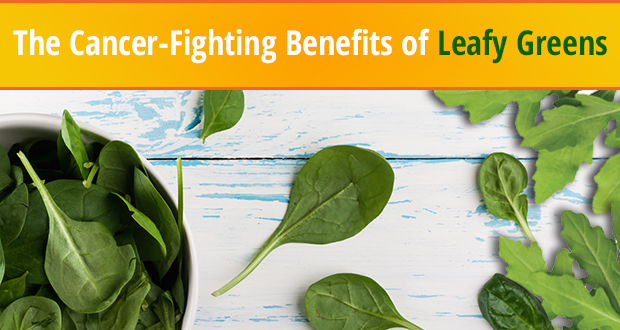Under their mothers’ watchful eye, children through the ages have eaten bland, bitter, and boring servings of spinach in the interest of their health and well-being. Thankfully, cooking shows and the internet have shown us how to prepare colorful, delicious versions of veggies that used to make us want to run away from the dinner table. The health benefits of leafy greens are so compelling that a little extra research into how to serve them is worth it.
Any book on healthy eating talks at length about the best fruits and vegetables for your total wellbeing. You may have heard that you’re supposed to consume rainbows of food every day in order to best support your anti-cancer lifestyle.
Rainbows include the color green.
Fruits are the easy part! Most people actually enjoy eating all sorts of citrus, melons, apples, and berries on a regular basis. Even carrots or strips of brightly colored peppers will slip into a child’s lunchbox – properly disguised as a “fun” food rather than a “good for you” one. They are crunchy and the perfect vehicle for a healthy snack such as hummus.
Unfortunately, when it comes to the dark green, leafy vegetables, many moms and dads are stumped on how to entice their kids to eat them. They look healthy. They smell healthy. Kids aren’t fooled for a minute!
Even with kale exploding to the forefront of the most recent health trends, you might be confused about what to do with the other choices available to you beneath the gentle water mists in the produce department.
Spinach isn’t just for dips in a bread bowl, kale isn’t as confusing as you think, and lettuce doesn’t always belong drowned in salad dressing and croutons.
Popular Leafy Greens to Add to Your Anti-Cancer Diet
- Arugula, endive, and other delicate lettuces
- Romaine lettuce
- Swiss chard
- Spinach
- Kale
- Parsley
- Collard, mustard, and beet greens
Dark leafy green vegetables are bursting with carotenoids, folate, chlorophyll, and fiber. These compounds help stop or slow the growth of some forms of cancer. They are excellent sources of vitamins, minerals, iron, and calcium – dozens of antioxidants that battle and remove free radicals from your body. The benefits of leafy greens affect your entire body in positive ways!
They are essential to help you stay young, keep your vision healthy, lower bad cholesterol, reduce your risk of heart disease, protect your bones, and lower your personal cancer risk according to a recent study published in the Journal of American Dietetic Association. Colorectal cancer doesn’t stand a chance if you power up your day with plenty of leafy greens.
Women who are pregnant should particularly up their intake of leafy greens and other folate-rich foods to aid in fetal development.
Organic or Non-Organic Leafy Greens?
According to the Shoppers’ Guide to Pesticides in Produce, compiled by the non-profit Environmental Working Group (EWG), leafy greens are one of the foods that still carry a high pesticide load after washing and storing normally.
As a general rule of thumb, if you’re not going to peel off the outside of a vegetable, it really is best to buy organic whenever possible. Organic produce can be more expensive in many cases, but your health should take priority if the difference is only pennies per pound.
How Many Leafy Greens Do You Need?
Basic guidelines for dietary consumption say that adults and teenagers should consume at least 2 cups of dark leafy greens per week. Children between the ages of 4 and 8 years should have approximately 1 cup. Two and 3-year-olds should have about ½ cup per week.
Remember that is just a guideline! Greens are powerhouses of nutrition, have a low glycemic index, and don’t pack a lot of calories, so don’t be afraid to eat more. A lot more. You’re not likely to overdose on chard or mustard greens.
Preparation and Storage of Leafy Greens
Whether or not you choose organic greens, make sure you wash and store them properly. Fill your sink or a large bowl with cold water. You can add a sprinkle of apple cider vinegar for the best results. Place the greens into the water and agitate gently with your hands. This removes any sand, grit, or bacteria attached to the leaves.
Don’t soak the greens. Once you’ve moved them around, rinse them well and place in another bowl or on a clean kitchen towel to dry. If you have a salad spinner, give them a spin. Remove any leaves that are wilted or beginning to yellow.
Store in a zip top bag with a folded paper towel to absorb any excess moisture but leave the bag open a bit to promote air circulation. Fresh greens, stored properly, should last up to 5 days in your crisper drawer.
How Should You Eat Your Leafy Greens?
There is no end to ways to serve up your leafy green benefits. Experiment with different methods and seasonings to find the way you like them best. Some people like their greens raw or only lightly wilted.
If you’re just beginning to incorporate these vegetables into your diet, you may want to begin by mixing a handful of greens into your salads. Baby greens, available in almost every grocery store, are bite-size and easy to toss into your bowl. Greens can be steamed or quickly sautéed. Add some fresh garlic, squeeze on some lemon juice, or sprinkle some red pepper flakes to add some zing.
Leafy greens can add an energizing boost to your breakfast smoothie that will last for hours. Mild greens such as baby spinach will blend into a smoothie and the kids won’t even taste it. (Just watch the colors of the other items in your smoothie. For example, too much green spinach in a strawberry smoothie can end up looking gray). Use leafy greens in your lunchbox as a salad or instead of iceberg lettuce on your sandwich. For dinner, you can hide finely diced leafy greens in your spaghetti sauce or layer in lasagna.
In order to receive the greatest nutritional oomph, you should eat your greens with a small amount of a healthy fat. Carotenoids and vitamin K are fat-soluble and you increase your absorption by combining your greens with healthy oils such as olive or coconut oil. Even grass-fed butter because it’s a healthy fat, too. No matter which method you choose, don’t be afraid to mix it up.
You can find (literally) hundreds of delicious recipes to add the benefits of leafy greens to your eating plan. These gorgeous dark veggies are going to be delicious and you may even be surprised at how much you learn to love them.
Your mom will be so happy too that you’re finally eating your vegetables!





















